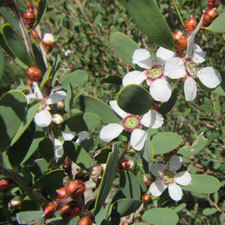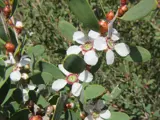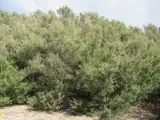 Coast tea tree
Coast tea tree
Common name: Coast tea tree
Botanical name: Leptospermum laevigatum
Management programme: Eradication
Coast tea tree is native to Australia and thought to have been brought to New Zealand primarily to help with stabilising sand dunes. Ironically, coast tea tree does the opposite, as it doesn’t trap the sand in the same way that our native dune species do.
Why is it a pest?
- This plant will crowd and out-grow native dune plant species.
- Waves flush sand from underneath the tree roots causing erosion and eventually pushing back and steepening the slope of the dune area.
- Even in its country of origin, coast tea tree is considered a significant environmental weed in Victoria and Western Australia due to its ability to dominate and create a mono culture wherever it establishes.
Where is it found?
Coast tea tree is present on Matakana Island. No other known locations exist in the Bay of Plenty.
Coast tea tree will happily growing on all parts of sand dune systems, both in direct sunlight and shade.
What does it look like?
- Coast tea tree is a woody shrub or small twisted tree up to 6m.
- White flowers appear between the months of August to October.
- Fruit is in hard, domed woody capsules that have 7-10 cells (New Zealand mānuka has 5 cells).
What are the rules?
Eradication
Coast tea tree is an Eradication pest which means that it is limited in its level of infestation in the region.
The Bay of Plenty Regional Council takes responsibility for its control. Please contact the Bay of Plenty Regional Council if you think you have found coast tea tree.
How do you get rid of it?
Please do not attempt to control coast tea tree yourself. Contact council and a biosecurity officer will get in touch to get more information and arrange a site visit.
Images


